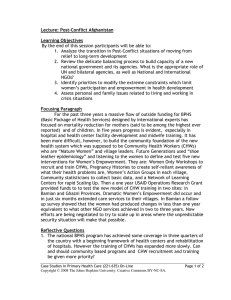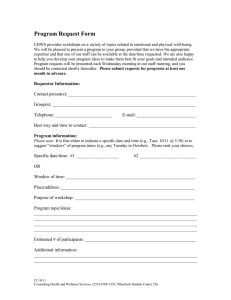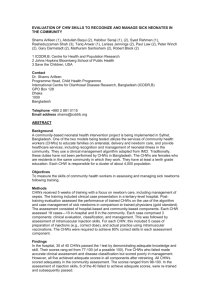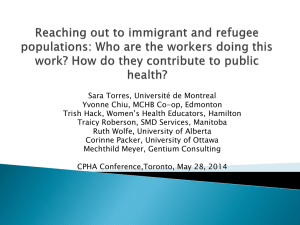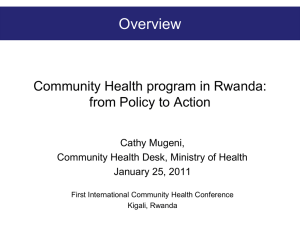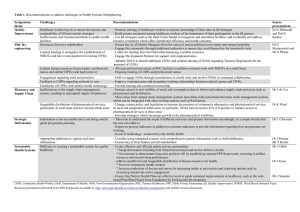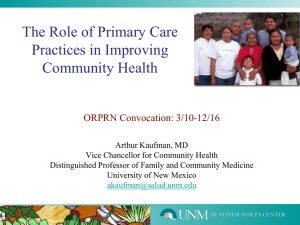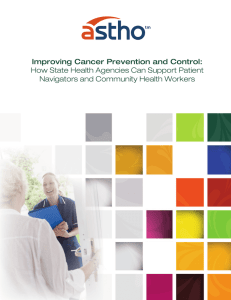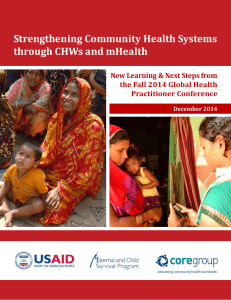CHW Interventions
advertisement
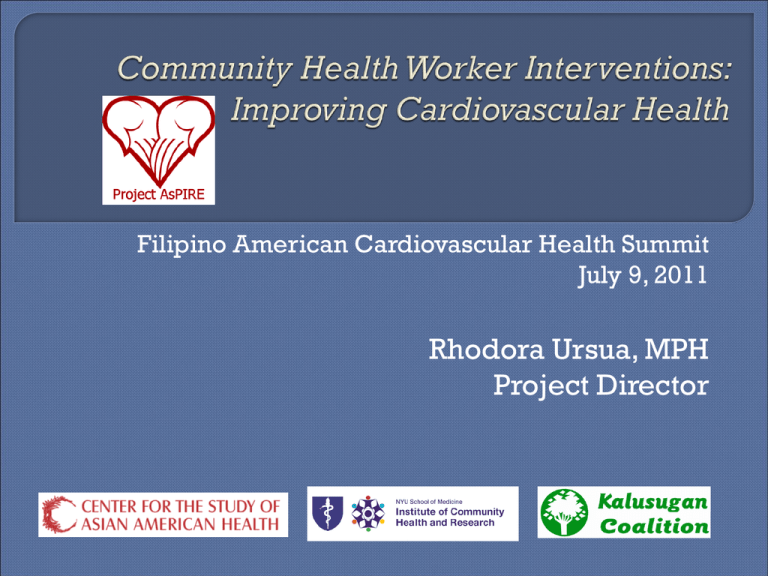
Filipino American Cardiovascular Health Summit July 9, 2011 Rhodora Ursua, MPH Project Director Feb 2004 Outreach April 2004 Community Forum Summer 2004 April 2005 Community Health Needs Assessment Sep 2005 Burgeoning literature demonstrating CHW effectiveness across many different conditions CHWs address social determinants of health Large workforce - 11,000 in NYS - 120,000 nationally Patient Protection and Affordable Care Act • Several elements of the federal health reform law can be facilitated through strong CHW participation • Increase access - Improve quality – Lower costs Patient-Centered Medical Homes, ACO, Health Homes • CHWs play important role in coordinating care and helping people manage care Frontline public health professionals Trusted members of the communities they serve Shared life experiences with population served Peer relationships – shared power Agents for change – micro and macro level Empowerment approach to interactions 29 elements identified Required further analysis – Statewide Market Survey of 226 CHWs and 44 CHW Employers Focus groups, key informant interviews, Community Participatory Ranking (CBPR) Elements fall into three domains Skills •Outreach/Organizing •Supportive counseling •Adult learning •Behavior change •Advocacy •Observation/Feedback •Env. assessment •Treatment adherence •Health literacy Qualities •Trustworthy •Community connection •Non-judgmental •Resourcefulness •Creative •Empathic •Peer relationships •Shared experiences Roles (Scope of Practice) •Health promotion & coaching •Home-based support •Outreach/Mobilization •Community/Cultural Liaison •Case management •System navigation •Participatory research Liaisons between communities and health and social service systems • Improve access to health care resources • Improve the quality and cultural appropriateness of service • • • • delivery Help people integrate disease prevention and management regimens into their daily life Organize communities to improve environmental, physical and social wellbeing Negotiate cultural & linguistic barriers to health Help people become active participants in their health Build community by combating social isolation and exclusion • Community organizing and empowerment Outreach/Community Mobilizing Strong interpersonal skills Multi-cultural /Bilingual skills Advocacy skills Group facilitation Information exchange System Navigation Patient navigation Interpretation and Translation Computer skills Ability to access information Community/Cultural Liaison Community organizing Community advocacy Translation and interpretation Participatory Research Facilitating translational research Interviewing Documentation Case Management/Care Coord. Supportive Counseling Goal Setting and Planning Time Management Service Coordination Home-based Support Safety procedures Environmental assessment Observation and documentation Health Promotion & Coaching Modeling behavior change Topic specific health care knowledge Chronic disease mgmt framework Adult learning methods Faith-based organizations/ Health professional associations Businesses Workers Apartments Church Events Link to health providers Monitor blood pressure Health promotion “We have strong connections to the community so we are able to influence people on how to be healthy. Oftentimes when I do home visits, the participants tell me how thankful they are. They never thought there would be someone that would go out of their way to visit them and show concern for their health and take their blood pressure.” –AsPIRE CHW Training new CHWs Data collection CPR training for household workers from Philippines Nurses Association •Individual level (i.e. advocate for patient’s needs at physician visits) •Systems level (i.e. advocate for streamlined referral systems with hospital administrators; public hearings to inform legislators of challenges community faces and recommended solutions) • Increased access and quality of services • Improved health outcomes • Reduced/eliminated persistent inequities in health outcomes • Increased social capital & community connectedness • Promote healthier communities and individuals • Lowered health care costs fewer resource-intensive ED visits Fewer hospitalizations & re-admissions Increased prevention and use of primary care Received Allocated intervention Did not received allocated intervention -11mmHg Systolic -3mmHg Systolic -7mmHg Diastolic Diastolic Remained the same Measured from baseline to 4th months. The differences in the means were significant at p<0.05 All individuals who received allocated intervention exhibited controlled blood pressure at the 4th month survey 32% of those who did not received allocated intervention exhibited uncontrolled hypertension Those who never forgot to refill their antihypertensive prescriptions from Baseline to 4th Month Received Allocated intervention 57% to 86% Did not received allocated intervention No Change Those who set their appointment before leaving the Doctor’s office Received Allocated intervention Did not received allocated intervention Slight increase from 50% to 53% No Change Measured from baseline to 4th months. Increased access • health insurance coverage increased & more consistent for children (RCT in Boston) Lower costs • • • • • 38% fewer ED visits 30% fewer hospitalizations 27% reduced Medicaid expenses (diabetes) average savings $2,245 per patient per year savings of $80,000 to $90,000 per year per CHW(Baltimore) Return on Investment Cost savings • ROI of $2.28 per dollar invested (underserved men in Denver) • $7.00 per dollar invested (Denver Health pregnancy testing program) • Decreased per capita expenses 97% in an asthma program (Hawaii) • $24 million over 9 years in Georgia private corp. Private/Corporate • Improved enrollment and retention (automatic enrollment) • Improved customer satisfaction (QAAR scores) • Improved case-finding (pregnancy & chronic diseases) • ROI (up to 7.0/1.0), Cost Savings ($80,000.00 per CHW/year) Medicaid Part 1115 Waiver • NYS Maternal Child Health Programs Team Integration • CHWs as members of reimbursable care teams • PCMH & ACO, Health Homes, Insurance Exchanges Direct Medicaid/Medicare reimbursement • CHWs as Medicaid/Medicare providers • Supervision CHWs are valuable in bridging gaps. CHWs help build self-sustaining organizations. CHWs aim to enhance the quality of life through increasing communities’ self-reliance and confidence through community empowerment as a result of mobilizing fellows with common goals. CHWs can advocate the implementation of healthcare acts to accommodate the needs of Asian Americans by participating in legislative visits. CHWs provide a voice for the unjust treatment of certain communities or individuals. This presentation was made possible by Grant Number R24 MD001786 from NIMHD and its contents are solely the responsibility of the authors and do not necessarily represent the official views of the NIMHD. THANK YOU! Rhodora Ursua, MPH, Director, Project AsPIRE 212-263-3776 rhodora.ursua@nyumc.org Center for the Study of Asian American Health New York University School of Medicine 550 First Ave, VZN Suite 726 New York, NY 10016 www.med.nyu.edu/csaah
